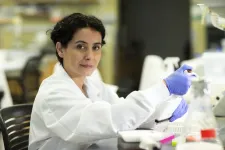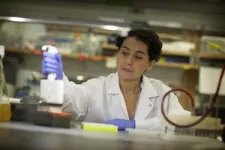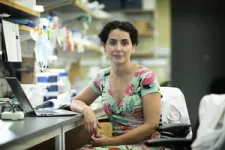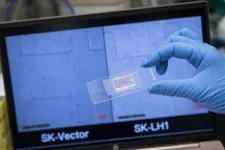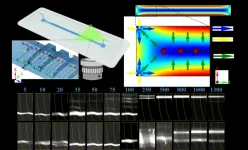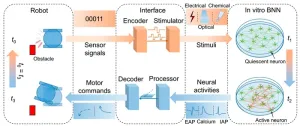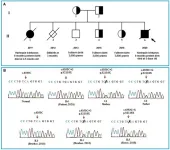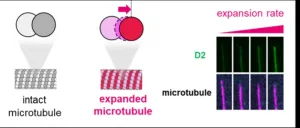(Press-News.org) University of Virginia scientists have identified a promising approach to delay aging by detoxifying the body of glycerol and glyceraldehyde, harmful by-products of fat that naturally accumulate over time.
The new findings come from UVA researcher Eyleen Jorgelina O’Rourke, PhD, and her team, who are seeking to identify the mechanisms driving healthy aging and longevity. Their new work suggests a potential way to do so by reducing glycerol and glyceraldehyde’s health-draining effects.
“The discovery was unexpected. We went after a very well-supported hypothesis that the secret to longevity was the activation of a cell-rejuvenating process named autophagy and ended up finding an unrecognized mechanism of health and lifespan extension,” said O’Rourke, of UVA’s Department of Biology and the UVA School of Medicine’s Department of Cell Biology. “An exciting aspect of the discovery is that the key to switch on this longevity mechanism is the activation of two enzymes that are very well studied because of their role in ethanol detoxification. [Ethanol is the alcohol contained in beer and bourbon]. This existing knowledge greatly facilitates our search for drugs that can specifically activate this anti-aging process.”
Anti-Aging Discovery
In their search for the secrets to slow down aging, O’Rourke and her graduate student Abbas Ghaddar and postdoc Vinod Mony turned to microscopic worms called C. elegans. These soil dwellers share more than 70% of our genes and are an invaluable tool for biomedical research; two Nobel prizes in medicine were awarded to discoveries made using this worm exclusively.
Prior aging research in worms, mice and human cells made O’Rourke and others in the field suspect that the key to extending lifespan was to activate autophagy, a process that renews broken and old parts in our cells. But O’Rourke and her collaborators were surprised to find that wasn’t necessary – the scientists improved the worms’ health and lifespan by 50% with no increase in autophagy at all.
They did this by capitalizing on a mechanism they discovered and named AMAR, the Sanskrit word for immortality. AMAR, in this instance, stands for “Alcohol and aldehyde-dehydrogenase Mediated Anti-aging Response.” In short, the scientists found that they could prompt an anti-aging response by putting the spurs to a particular gene, adh-1. Doing so prompted the gene to produce more of an enzyme, alcohol dehydrogenase, that prevented the toxicity caused by glycerol and, indirectly, glyceraldehyde. The result was that the worms lived longer, healthier lives.
Findings in lab models such as worms and mice don’t always hold true in people, of course. So the researchers took several more steps to see if their lead was as promising as it appeared. First, they confirmed that the enzyme had similar beneficial effects on lifespan in another lab model, yeast. Then they scoured through research looking at gene activity in creatures, including humans, who had undergone fasting or calorie restriction because both fasting and calorie restriction are known to extend healthspan and lifespan. Sure enough, the scientists found increased levels of the anti-aging enzymes in all the mammals tested, including in humans.
The scientists suspect that our levels of glycerol and glyceraldehyde naturally increase over time because they are toxic byproducts of fat, which we store more of as we age. Thus, AMAR may offer a way to head off the fat-derived toxicity, extend the number of years we live in good health, and maybe help us shed some extra pounds, too.
“We hope to attract interest in developing therapeutics that target AMAR,” said O’Rourke, who is part of UVA’s Robert M. Berne Cardiovascular Research Center. “With age-related diseases currently being the major health burden for patients, their families and the healthcare system, targeting the process of aging itself would be most effective way to reduce this burden and increase the number of years of independent healthy living for all of us.”
Findings Published
The researchers have published their findings in the scientific journal Current Biology. The team consisted of Abbas Ghaddar, Vinod K. Mony, Swarup Mishra, Samuel Berhanu, James C. Johnson, Elisa Enriquez-Hesles, Emma Harrison, Aaroh Patel, Mary Kate Horak, Jeffrey S. Smith and O’Rourke. The researchers have no financial interests in the work.
The research was supported by the National Institutes of Health, grants RO1GM075240, RO1GM127394 and DK087928, and National Research Service Award F30AG067760. Additional funders include the Pew Charitable Trusts, the Jeffress Trust, the W.M. Keck Foundation, the Jefferson Scholars Foundation and UVA’s Society of Fellows, Medical Scientist Training Program and a cell and molecular biology training grant.
To keep up with the latest medical research news from UVA, subscribe to the Making of Medicine blog at https://makingofmedicine.virginia.edu.
END
Detoxing body of 2 fat by-products could extend lifespan, UVA researchers discover
2023-03-09
ELSE PRESS RELEASES FROM THIS DATE:
In the world’s smallest ball game, scientists throw and catch single atoms using light
2023-03-09
WASHINGTON —In many baseball-obsessed countries like Korea, Japan and the United States, with spring months comes the start of the season and quite a few balls flying through the air. But it’s not just balls that can be thrown. On the tiniest field imaginable, scientists have now shown they can also throw and catch individual atoms using light.
This amazing feat was achieved with optical traps, which use a highly focused laser beam to hold and move tiny objects. Although optical traps have been used to move individual atoms before, this is the first time ...
HSS presents research at 2023 AAOS Annual Meeting
2023-03-09
At this year’s American Academy of Orthopaedic Surgeons (AAOS) Annual Meeting, held March 7 to 11 in Las Vegas, Hospital for Special Surgery (HSS) presented new research on a variety of topics in orthopedic surgery, including studies related to minimally invasive surgery, racial disparities, and opioid alternatives for pain management in spine care.
What follows are some highlights from the meeting:
Intravenous versus Oral Administration of Acetaminophen Perioperative to Instrumented Lumbar Fusion: A Single-Center, Randomized Controlled Trial
In patients undergoing ...
CityU researchers identify a protein that promotes cancer metastasis, providing a new potential treatment target
2023-03-09
Cancer metastasis is a major cause of cancer-related death. A research team at City University of Hong Kong (CityU) recently identified a protein that triggers the migration of liver and pancreatic cancer cells and metastasis, and is correlated with shortening the survival time of patients. The research findings were verified by in vitro and in vivo models, supported with clinical data, and are expected to provide a new potential target for cancer therapy.
“Cancer metastasis is a complex process. Stiffness in tumours and the surrounding tissues is known to increase along with the tumour growth, which creates confined spaces or channel-like tracks of pores for tumour ...
An on-chip viscoelasticity sensor for biological fluids
2023-03-09
A research paper by scientists at the Hebei University of Technology and Shenzhen University developed an on-chip viscoelasticity sensor for biological fluids.
The new research paper, published on Jan. 10, 2023 in the journal Cyborg and Bionic Systems, reported a double-layered microfluidic sensor to detect the ultra-weak viscoelasticity in biological fluids.
“Most of human body fluids are non-Newtonian liquids, and the influence of viscoelasticity is often ignored for the sake of simplification of analysis. However, we ...
An overview of in vitro biological neural networks for robot intelligence
2023-03-09
A review paper by scientists at the Beijing Institute of Technology summarized recent efforts and future potentials in the use of in vitro biological neural networks (BNNs) for the realization of biological intelligence, with a focus on those related to robot intelligence.
The review paper, published on Jan. 10 in the journal Cyborg and Bionic Systems, provided an overview of 1) the underpinnings of intelligence presented in in vitro BNNs, such as memory and learning; 2) how these BNNs can be embodied with robots through bidirectional ...
ASBMB announces 2023 class of fellows
2023-03-09
The American Society for Biochemistry and Molecular Biology today announced its 2023 class of fellows. The honorific program recognizes scientists who have made outstanding contributions to the field through their research, teaching, mentoring or other forms of service.
The society will recognize the 20 new fellows at its annual meeting, Discover BMB, later this month in Seattle. The presentation will be part of the society's presidential address and business meeting scheduled for Saturday, March 25.
“This group truly represents members who have ...
Novel rare skin mutation gene identified by whole exome sequencing - BGI Case Report
2023-03-09
Harlequin ichthyosis (HI) is a severe genetic skin disorder characterized by thick white, brown, or dark brown patches on the skin covering a newborn's entire body. HI has a low incidence of 1 per 300,000 live births but comes with the highest mortality rate among skin conditions. It is caused by a mutation in the ABCA12 gene, which codes for a protein involved in transporting lipids necessary for the formation of the skin barrier. Such protein shortage leads to a weaker epidermal barrier.
A recent study, co-authored by BGI Genomics Dr. Thomas Qiu, published in Frontiers in Pediatrics covers ...
Like a flexible Lego railway track: How stable microtubules form within cells
2023-03-09
Like poles support a tent, microtubules—hollow cylindrical structures made of tubulin protein—support eukaryotic cells. But microtubules provide more than just mechanical strength; they help prepare the cell for cell division and migration and work as a railway track on which motor proteins transport materials within the cell. The formation of microtubules within cells resembles how a child assembles a Lego train track. The tubulins—Lego bricks—constantly assemble and disassemble to make the microtubule—train track—longer and shorter in processes called polymerization and depolymerization. The processes are regulated by microtubule-associated proteins such ...
What if California didn’t close down during the pandemic?
2023-03-09
SAN FRANCISCO (March 9, 2023) — Researchers at the California Academy of Sciences, along with a collaborator at Denison University, have developed an innovative new model to assess how the California economy might have fared without economic closures to slow the spread of the coronavirus pandemic. Their initial findings—published today in Frontiers in Physics—reveal that under a “business-as-usual” approach wherein there were no business closures, California’s economy would have generally been better off than in reality. However, the economic impacts would still have been substantial and ...
Americans share fake news to fit in with social circles
2023-03-09
Both conservative and liberal Americans share fake news because they don’t want to be ostracized from their social circles, according to research published by the American Psychological Association.
“Conformity and social pressure are key motivators of the spread of fake news,” said lead researcher Matthew Asher Lawson, PhD, an assistant professor of decision sciences at INSEAD, a business school in France. “If someone in your online tribe is sharing fake news, then you feel pressure to share it as well, even if you don’t ...
